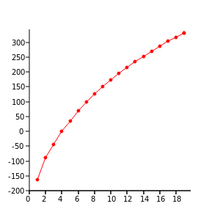Homologous series
In the field of organic chemistry, a homologous series is a sequence of compounds with the same functional group and similar chemical properties in which the members of the series can be branched or unbranched.[1] This can be the length of a carbon chain,[1] for example in the straight-chained alkanes (paraffins), or it could be the number of monomers in a homopolymer such as amylose.[2]
Compounds within a homologous series typically have a fixed set of functional groups that gives them similar chemical and physical properties. (For example, the series of primary straight-chained alcohols has a hydroxyl at the end of the carbon chain.) These properties typically change gradually along the series, and the changes can often be explained by mere differences in molecular size and mass. The name "homologous series" is also often used for any collection of compounds that have similar structures or include the same functional group, such as the general alkanes (straight and branched), the alkenes (olefins), the carbohydrates, etc. However, if the members cannot be arranged in a linear order by a single parameter, the collection may be better called a "chemical family" or "class of homologous compounds" than a "series".
The concept of homologous series was proposed in 1843 by the French chemist Charles Gerhardt.[3] A homologation reaction is a chemical process that converts one member of a homologous series to the next member.
Examples
The homologous series of straight-chained alkanes begins methane (CH4), ethane (C2H6), propane (C3H8), butane (C4H10), and pentane (C5H12). In that series, successive members differ in mass by an extra methylene bridge (-CH2- unit) inserted in the chain. Thus the molecular mass of each member differs by 14 atomic mass units. Adjacent members in such a series, such as methane and ethane, are known as "adjacent homologues".[4]

Within that series, many physical properties such as boiling point gradually change with increasing mass. For example, ethane (C2H6), has a higher boiling point than methane (CH4). This is because the London dispersion forces between ethane molecules are higher than that between methane molecules, resulting in stronger forces of intermolecular attraction, raising the boiling point.
Some important classes of organic molecules are derivatives of alkanes, such as the primary alcohols, aldehydes, and (mono)carboxylic acids form analogous series to the alkanes. The corresponding homologous series of primary straight-chained alcohols comprises methanol (CH4O), ethanol (C2H6O), 1-propanol (C3H8O), 1-butanol, and so on. The single-ring cycloalkanes form another such series, starting with cyclopropane.
| Homologous series | General formula | Repeating unit | Functional group(s) |
| Straight-chain alkanes | CnH2n + 2 (n ≥ 1) | −CH2− | H3C− ... −CH3 |
| Straight-chain perfluoroalkanes | CnF2n + 2 (n ≥ 1) | −CF2− | F3C− ... −CF3 |
| Straight-chain alkyl | CnH2n + 1 (n ≥ 1) | −CH2− | H3C− ... −CH2− |
| Straight-chain 1-alkenes | CnH2n (n ≥ 2) | −CH2− | H2C=C− ... −CH3 |
| Cycloalkanes | CnH2n (n ≥ 2) | −CH2− | Singly-bonded ring |
| Straight-chain 1-alkynes | CnH2n − 2 (n ≥ 2) | −CH2− | HC≡C− ... −CH3 |
| polyacetylenes | C2nH2n + 2 (n ≥ 2) | −CH=CH− | H3C− ... −CH3 |
| Straight-chain primary alcohols | CnH2n + 1OH (n ≥ 1) | −CH2− | H3C− ... −OH |
| Straight-chain primary monocarboxylic acids | CnH2n + 1COOH (n ≥ 0) | −CH2− | H3C− ... −COOH |
| Straight-chain azanes | NnHn + 2 (n ≥ 1) | −NH− | H2N− ... −NH2 |
Biopolymers also form homologous series, for example the polymers of glucose such as cellulose oligomers[5] starting with cellobiose, or the series of amylose oligomers starting with maltose, which are sometimes called maltooligomers.[6] Homooligopeptides, oligopeptides made up of repetitions of only one amino acid can also be studied as homologous series.[7]
Inorganic homologous series
Homologous series are not unique to organic chemistry. Titanium, vanadium, and molybdenum oxides all form homologous series (e.g. VnO2n − 1 for 2 < n < 10), as do the silanes, SinH2n + 2 (with n up to 8) that are analogous to the alkanes, CnH2n + 2.
References
- ^ a b 1928-, Brown, (Theodore L. (Theodore Lawrence) (1991). Chemistry : the central science. LeMay, H. Eugene (Harold Eugene), 1940-, Bursten, Bruce Edward. (5th ed.). Englewood Cliffs, NJ: Prentice Hall. pp. 940. ISBN 978-0-13-126202-7. OCLC 21973767.
{{cite book}}:|last=has numeric name (help)CS1 maint: multiple names: authors list (link) - ^ Saarela, K. (2013-10-22). Macromolecular Chemistry—8: Plenary and Main Lectures Presented at the International Symposium on Macromolecules Held in Helsinki, Finland, 2–7 July 1972. Elsevier. p. 88. ISBN 978-1-4832-8025-7.
- ^ Charles Gerhardt (1843) "Sur la classification chimique des substances organiques" (On the chemical classification of organic substances), Revue scientifique et industrielle, 14 : 580–609. From page 588: "17. Nous appelons substances homologues celles qui jouissent des même propriétés chimiques et dont la composition offre certaines analogies dans les proportions relatives des éléments." (17. We call homologous substances those that have the same chemical properties and whose composition offers certain analogies in the relative proportions of elements.)
- ^ See In re Henze, 181 F.2d 196, 201 (CCPA 1950), in which the court stated, "In effect, the nature of homologues and the close relationship the physical and chemical properties of one member of a series bears to adjacent members is such that a presumption of unpatentability arises against a claim directed to a composition of matter, the adjacent homologue of which is old in the art."
- ^ Rojas, Orlando J. (2016-02-25). Cellulose Chemistry and Properties: Fibers, Nanocelluloses and Advanced Materials. Springer. ISBN 978-3-319-26015-0.
- ^ Advances in Carbohydrate Chemistry and Biochemistry. Academic Press. 1981-06-19. ISBN 978-0-08-056297-1.
- ^ Giddings, J. Calvin (1982-08-25). Advances in Chromatography. CRC Press. ISBN 978-0-8247-1868-8.
